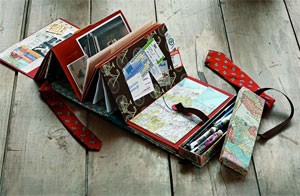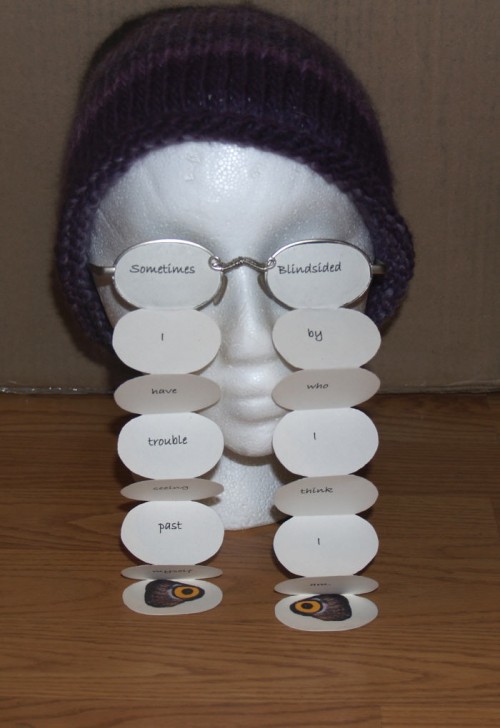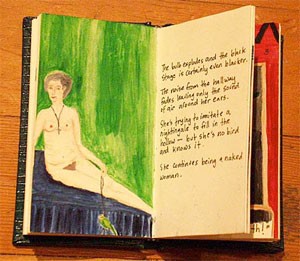 As a follow-up on my recent post on Jeannine Stein’s thoughts on what bookmaking means to her, I’ve been looking for comments by other bookmakers. I ran across a set of interviews from 2000, in the journal How 2 called Livres de Poètes: Six poets talk about the books they make. The interviewer, poet and book artist Dale Going, says: "In co-curating, with Jaime Robles, an exhibition in June 2000 at the Berkeley Arts Center called Livres de poètes (femme), I’ve had the pleasure of reading, handling, looking at, experiencing about a hundred such handmade books by poet/book artists whose work balances on the textual/visual cusp. I talked with six artists whose work covers a range of methods, techniques, and intentions." (entire intro to the interviews here.) The poets/bookmakers she interviewed are:
As a follow-up on my recent post on Jeannine Stein’s thoughts on what bookmaking means to her, I’ve been looking for comments by other bookmakers. I ran across a set of interviews from 2000, in the journal How 2 called Livres de Poètes: Six poets talk about the books they make. The interviewer, poet and book artist Dale Going, says: "In co-curating, with Jaime Robles, an exhibition in June 2000 at the Berkeley Arts Center called Livres de poètes (femme), I’ve had the pleasure of reading, handling, looking at, experiencing about a hundred such handmade books by poet/book artists whose work balances on the textual/visual cusp. I talked with six artists whose work covers a range of methods, techniques, and intentions." (entire intro to the interviews here.) The poets/bookmakers she interviewed are:
Lisa Kokin (her website)
"I don’t just make books: I also make sculpture and installation art…"
Emily McVarish (more of her work)
"I’ve been really interested in the three-dimensional and mechanical aspects of reading and poetics…"
Denise Newman
"I began making books over a series of summers spent writing on the Danish island of Bornholm…"
Eléna Rivera (website with her poetry)
"I used to write and make books as a child, so for me, making letterpress books was a rediscovery of book making…"
Jaime Robles (read some of her poetry)
"I started working with books when I was fairly young; in college I majored in both English and art…"
Meredith Stricker (one of her books, Alphabet Theater, and see part of the book on GoogleBooks)
"Thinking about my own history of writing, it has become clear to me that it’s not that there was poetry and then there were books; the materials and objects were the poetry…"
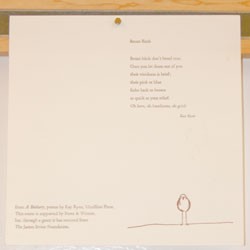 It’s been a long time since I posted a book in my artist’s book collection. Then the other day I read that the poet Kay Ryan had gotten a MacArthur Fellow Genius award. I have a broadside from a reading she did at the SF Center for the Book in 2001 hanging near my own press (that’s it to the left — click on it to get a larger image and read the poem). Ryan had allowed the Center to use her poetry in a book produced by a year-long letterpress class — the text is in Centaur, set by hand, and the drawings, by Michelle Geiger, were done in photopolymer. I also have a copy of that book, which I happily re-read. The title page is shown below.
It’s been a long time since I posted a book in my artist’s book collection. Then the other day I read that the poet Kay Ryan had gotten a MacArthur Fellow Genius award. I have a broadside from a reading she did at the SF Center for the Book in 2001 hanging near my own press (that’s it to the left — click on it to get a larger image and read the poem). Ryan had allowed the Center to use her poetry in a book produced by a year-long letterpress class — the text is in Centaur, set by hand, and the drawings, by Michelle Geiger, were done in photopolymer. I also have a copy of that book, which I happily re-read. The title page is shown below.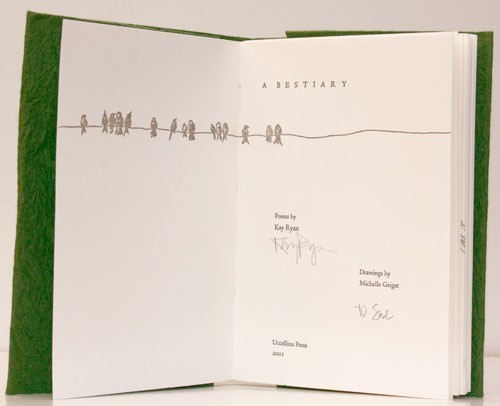

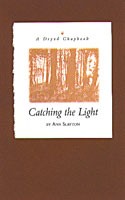
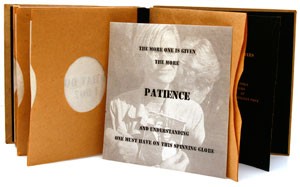 For the past week the news has been full of pieces about the upcoming 9/11 anniversary. Ten years ago I’d just started a year-long class on artist’s books at the
For the past week the news has been full of pieces about the upcoming 9/11 anniversary. Ten years ago I’d just started a year-long class on artist’s books at the 
